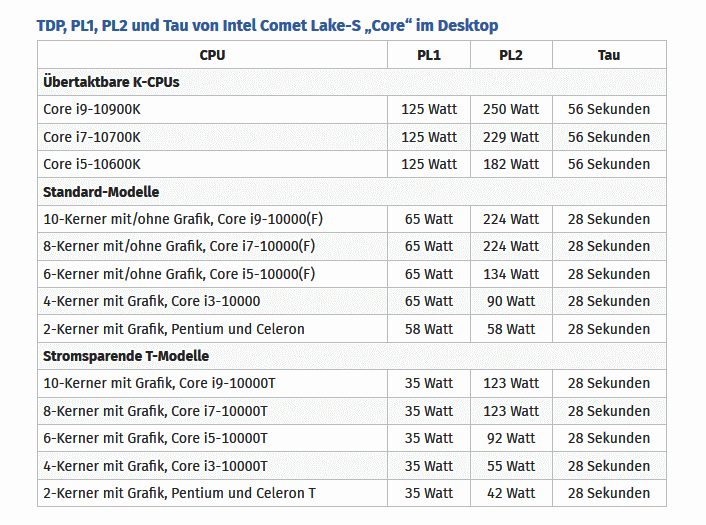INTEL has finally revealed the “power state limit’ values of its 10’th gen Comet Lake-S series of desktop processors, as evident from the latest revised Intel 10th Gen Core Datasheet, coming via Computerbase.
“The (PDF) file details the PL1 (Power Level 1), PL2 (Power Level 2) and Tau values for the new Comet Lake 14nm chips. This info was not available in the previous revision”. This is important because the actual power consumption of Intel processors is not directly related to the advertised TDP value.
Intel was called out for not “publicly” advertising the peak power consumption of its processors. The chipmaker only discloses the PL1 value, which is the CPU’s “base clock” speed’s power draw. The PL2 variable, on the other hand, is significantly much higher since it’s the “maximum” power consumption that you can expect when you push the processor to the limit.
Honestly speaking, labeling a processor for example having a 250Watts TDP value is not very good for business, especially when the majority of consumers/gamers won’t be seeing this level of power consumption draw during normal usage. Nevertheless, it’s a “very” crucial aspect of any processor that should be made public, and not to be overlooked or ignored. INTEL should list the “PL2 value” on the ARK product database. Period.
For example, some of the Intel’s eight-core processors are still rated at a TDP of 95 W, and yet we are seeing power consumption around 150-180W+, which doesn’t make that much sense. To clarify, there are three main variables or parameters to be aware of. These are PL1 (power level 1), PL2 (power level 2), and T (or tau).
When Intel released the Comet Lake lineup, even the reviewers were not provided with the CPU’s actual power state limit values. Now, the recent data confirms that Comet Lake-S CPU’s power level values are much different when compared to the previous generation of processors.
The “Core i9-10900K” which is a 10-core flagship chip, has a PL2 value that’s two times higher than the advertised PL1 value of 125W. The Core i7-10700K and Core i5-10600K on the other hand show a 1.83x and 1.46x increase in their PL2 values, respectively. When it comes to the 65W SKUs, the multipliers vary from 1.38x to 3.45x, depending on the model of the processor. As for the T-series, we can see the PL2 rise between 1.57x to 3.51x.
Intel has now confirmed that a 3.5 higher power limit (in PL2 state) is certainly possible for some of the Comet Lake-S processors, which is over the official TDP value. As an example, the Core i9-10900T, which is having a 35 Watts TDP, has a PL2 value of 123 watts (approx 3.5 times higher). Regular 65 Watts desktop SKUs can have the PL state value adjusted up to 224 Watts, which means roughly 3.45x higher power usage. The higher the PL2 value and longer Tau, the more the CPU will stay in boost mode, which means “higher” clock frequencies.
As I previously mentioned before, ASUS introduced a new feature called “ASUS Performance Enhancement” for the Intel 400-series chipset motherboards, similar to ASRock’s BFB. It works in a similar manner, and the motherboard vendor is actually increasing the processor’s PL1 (power level 1) from the default value to the maximum value, and locking it at that higher value.
This feature overrides the PL1 variable (power level 1) on 65W non-K Intel Core processors, allowing the CPU to sustain a higher clock speed, once the Turbo Boost algorithm has dropped Tau.
“Tau” is a timing variable. It dictates how long a processor should stay in PL2 mode before hitting a PL1 mode, or before having to fall back to the “base” frequency. Do note that Tau is not dependent on power consumption, nor is it dependent on the temp of the processor (because if the CPU hits a “thermal” threshold limit, then a different set of low voltage/frequency value curves are used and PL1/PL2 is discarded.
PL1 is the expected steady state power consumption of any processor (long term). The PL1 is usually defined as the TDP of a processor.
So if the TDP is 60W, then PL1 is 60W. PL2 on the other hand is the short-term maximum power draw for a processor. This number is higher than PL1, and the processor will go into this state when a stress or workload is applied, allowing the CPU model to use its turbo modes up to the maximum PL2 defined value.
Table/Chart courtesy of Computerbase
Hello, my name is NICK Richardson. I’m an avid PC and tech fan since the good old days of RIVA TNT2, and 3DFX interactive “Voodoo” gaming cards. I love playing mostly First-person shooters, and I’m a die-hard fan of this FPS genre, since the good ‘old Doom and Wolfenstein days.
MUSIC has always been my passion/roots, but I started gaming “casually” when I was young on Nvidia’s GeForce3 series of cards. I’m by no means an avid or a hardcore gamer though, but I just love stuff related to the PC, Games, and technology in general. I’ve been involved with many indie Metal bands worldwide, and have helped them promote their albums in record labels. I’m a very broad-minded down to earth guy. MUSIC is my inner expression, and soul.
Contact: Email


